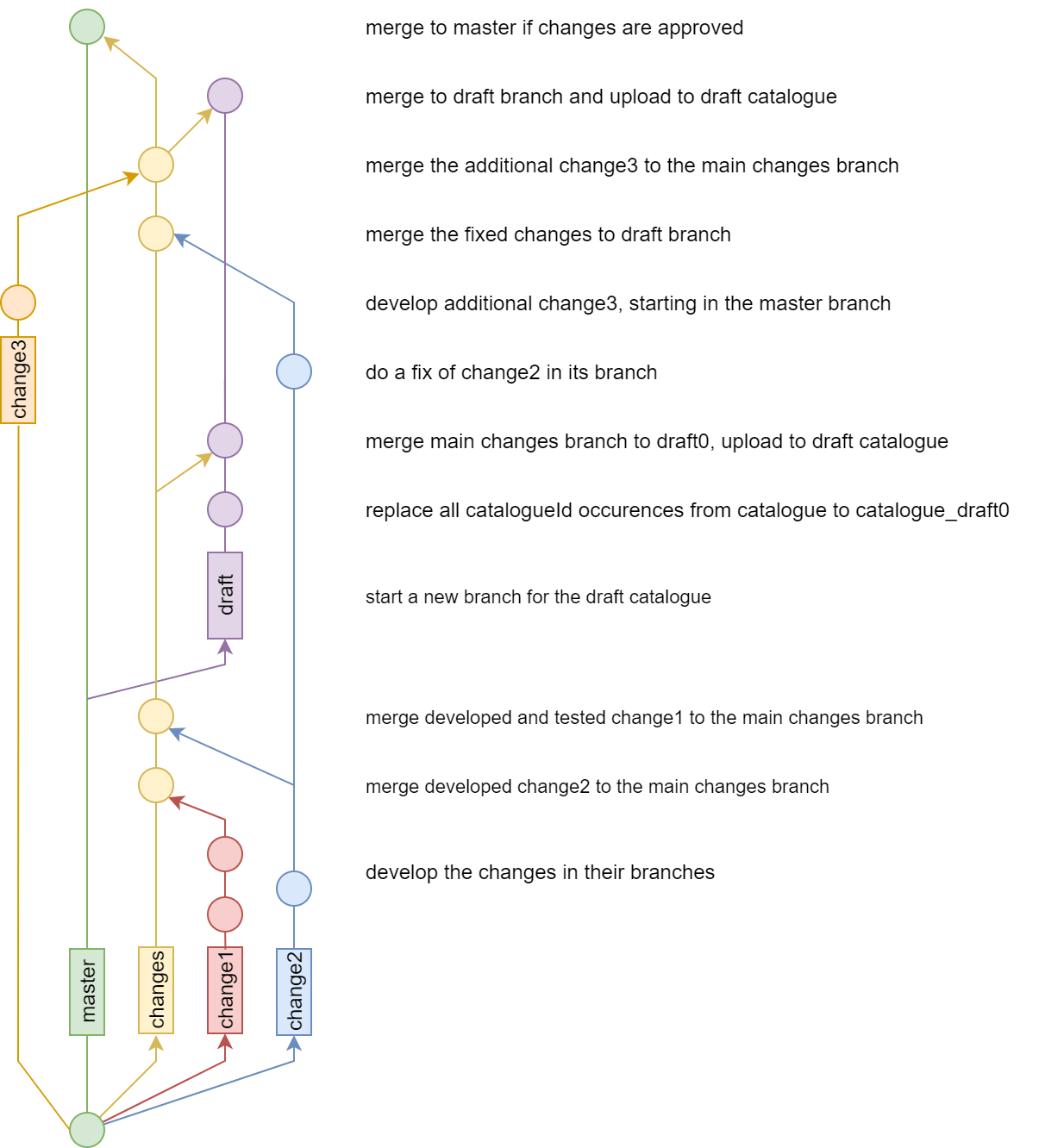# Processes and Good Practices
This chapter provides info to understand, how to efficiently handle your component definitions. Those are recommendations that we have found out to be working well for us.
# Reinitialize from Catalogue
# Publishing a Change of a Live Product to a Draft Catalogue for Client Approval
Situation: You have to make changes in a live product, but have to test them before go-live.
Here it is best to utilize the draft catalogue feature. Every catalogue has a possibility to create a draft catalogue. If you do so, the original catalogue locks for changes and you should do your work in the draft catalogue. After the change is done in the draft catalogue, you can use the RuAd publishing, where you take the content in the draft, which then overwrites the content in the live catalogue. You can select whether components, items, prices, meshes, materials should merge or be ignored, but it is all or nothing in every of those categories.
If you need to selectively publish only particular entries, or you need to work in more than one draft, or you need to publish entries into the live catalogue, you can do so by unlocking the original catalogue, but then you do not have a native merging possibility and you must merge the data yourself by using the standard catalogue import functionalities, while changing the catalogueIds accordingly.
Prerequisities:
- Master branch mirrors the state of the live catalogue.
- Data are stored in a proper way. All components are formatted with latest version of the Roomle Component Formatter.
Starting in the
masterbranch, create a new branch that will aggregate thechanges. Call the branch in a good way, for example<productName>/<JIRA-CODE>-changes, where<JIRA-CODE>stands for a aggregate ticket for the batch of changes. If not available, you can replace this by<YY-MM-changes>or in another way that you later know what and why was happening. If there is only one ticket to handle, use the standart branch naming conventions.Start every change in the
masterbranch and work on them parallel.
WARNING: It is highly not recommended to start change2 at the tip of change1, or to develop change1, merge to changes and start change2 in changes. This way you loose the possibility to (easily) reject some of the changes when the task is redefined or cancelled.
After all individual changes will have been done and tested on the developer's side, merge them to the
changesbranch.Starting in
master, create adraft0ordrafts/draft0branch (based on the actual number in the draft catalouge's ID)Change the catalogueIds of the relevant data to the draft catalogue IDs.
You usually need to make a copy of components and items for the draft. For this, you can do a replacement of:
- Full-text
d": "catalogue:->d": "catalogue_draft0:to changeid,itemId,componentIdfields. Watch out for field, where you assign a material value to a parameter/variable that ends with the letterd. - Full-text
""componentId"":""catalogue:->""componentId"":""catalogue_draft0:to change item configurations from an exportedallItems.csvfile; watch out for if there are spaces between"": ""
It is fine that components and items are taken from the draft, but materials and meshes are taken from the live catalogue. If you need to change or add new materials and meshes, it is fine that you refer only the changed or added meshes/materials in the draft catalogue. In such case, have only the relevant material or mesh IDs in the draft. However, you should change every occurence of such ID. You can do this by replacing:
- Full-text
AddExternalMesh('catalogue:<changed mesh id>'->AddExternalMesh('catalogue_draft0:<changed mesh id>'for calling meshes - Full-text
"catalogue:<changed material id>"->"catalogue:<changed material id>"for material IDs inside the Roomle Component Definition JSON values - Full-text
'catalogue:<changed material id>'->'catalogue:<changed material id>'for material IDs inside RoomleScripts. However, you should check in Git diff view if there are IDs insideAddExternalMeshfunctions affected, which is probably unintended.
Do a commmit in the
draftbranch, so that all data you're going to upload have the draft catalougeId.Merge the
changesbranch todraftbranch. If there's any new data, change their catalogueId during the merge or in the next commit to thedraftbranch.Upload
draftto the draft catalogue.Check if the functionality in the draft catalogue matches your expectations.
Hand the task over to your PM or to the client and wait for approval.
If approved, merge
changestomasterand upload to the live catalogue. If not approved, do fixes based on thechangesbranch or do new requests based on themasterbranch and go back to step 7.
Scheme of the just described process, as it would look like in a Git repository follows:

WATCH OUT FOR having draft IDs in any branch outside the draft. Otherwise you can end with referring to a draft catalogue in the live product, which will sooner or later bring crashes to a live product configurator.
